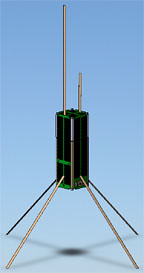Bread & Satellites
If you’ve spent some time in Ann Arbor, Michigan, you may have come across a Zingerman’s — a host of specialty foods delis, restaurants and related businesses. They’re known for having one of the best mail-order breads in the U.S.

The University of Michigan’s Student Space Systems Fabrication Laboratory is working on a micro-satellite about the size of a loaf of bread. The story, via Space Daily, gives us more:
U.S. scientists say they are developing a satellite about the size of a loaf of bread that will be deployed to study space weather.
The National Science Foundation-funded project called Radio Explorer, or RAX, is being led by the University of Michigan and the SRI International Corp., a California independent research and technology development organization.
The satellite, called CubeSat, is to be the first free-flying spacecraft, and will be built, in part, by members of the university’s Student Space Systems Fabrication Laboratory.
CubeSats are approximately 4-inch cube-shaped devices that launch from inside a P-Pod — a special rocket attachment developed by California Polytechnic State University and Stanford University.
The RAX satellite will essentially be made of three CubeSats and will measure the energy flow in the Earth’s ionosphere, where solar radiation turns regular atoms into charged particles.
"This project will help us better understand space weather processes, how the Earth and sun interact and how this weather produces noise in space communication signals — noise that translates to lower quality telecommunications capabilities and error in GPS signals," said Assistant Professor James Cutler, a co-principal investigator with physicist Hasan Bahcivan of SRI.
The grants from the National Science Foundation, who use a less-imaginative "half gallon carton of milk" metaphor, hopes to develop more student interest in space, too:
The National Science Foundation (NSF) has awarded a grant to SRI International, an independent non-profit research and development organization based in Menlo Park, Calif., to carry out the first space weather CubeSat mission.
CubeSats are tiny satellites with dimensions of 10��10��10 centimeters, weighing about 1 kilogram, and typically using commercial off-the-shelf electronics components.
Developed through joint efforts, California Polytechnic State University and Stanford University introduced CubeSats to academia as a way for universities throughout the world to enter the realm of space science and exploration.
According to atmospheric scientists, CubeSats have the potential to be excellent platforms for technology development and small science missions, and promote student involvement in design, fabrication and flight missions.
"One of the goals is to help train future space scientists and aerospace engineers," said Therese Moretto Jorgensen, program director in NSF’s Division of Atmospheric Sciences. "CubeSats will also help answer questions in space weather such as the cause of disturbances in the ionosphere, and the rise and decay of the Earth’s radiation belts during geomagnetic storms."

SRI International’s team will include many, including support from NASA:
“SRI is excited about the NSF contract, and working in collaboration with the University of Michigan,” said Hasan Bahcivan, research physicist at SRI International. “This program provides a cost effective way to support space weather and atmospheric research. It is also well positioned to provide excellent training opportunities for students that hope to become engineers or scientists. We expect 20 to 30 students to take significant roles in the design, development, and science operations of the satellite.”
The project’s mission is designed to remotely explore small-scale ionization structures in the form of plasma turbulence that occurs in response to intense electrical currents in the space environment. The structures can adversely impact communication and navigation signals by perturbing the refractive index along the signal propagation paths. By utilizing signals from powerful transmitters on the ground and receiving the scattered signals in space, researchers are achieving effective and powerful space-based radar to probe these structures, which would be expensive to accomplish via a stand-alone satellite radar.
"We have a multidisciplinary, cross-departmental team working on the project, that includes several engineers and faculty, and a large number of undergraduate and graduate students," said James Cutler, an assistant professor in the Aerospace Engineering Department at the University of Michigan. "My research laboratory will be partnering with several space-related classes and the Student Space Systems Fabrication Laboratory (S3FL) to build and fly RAX."
The first launch opportunity for the NSF satellite program will be with the Department of Defense Space Test Program, and is scheduled for December 2009 aboard a Minotaur-4 launch vehicle out of Kodiak, Alaska. Commissioning and launch support for the mission will be provided by NASA Goddard Space Flight Center Wallops Flight Facility.
This is the kind of government support we need to develop the future of rocket science.